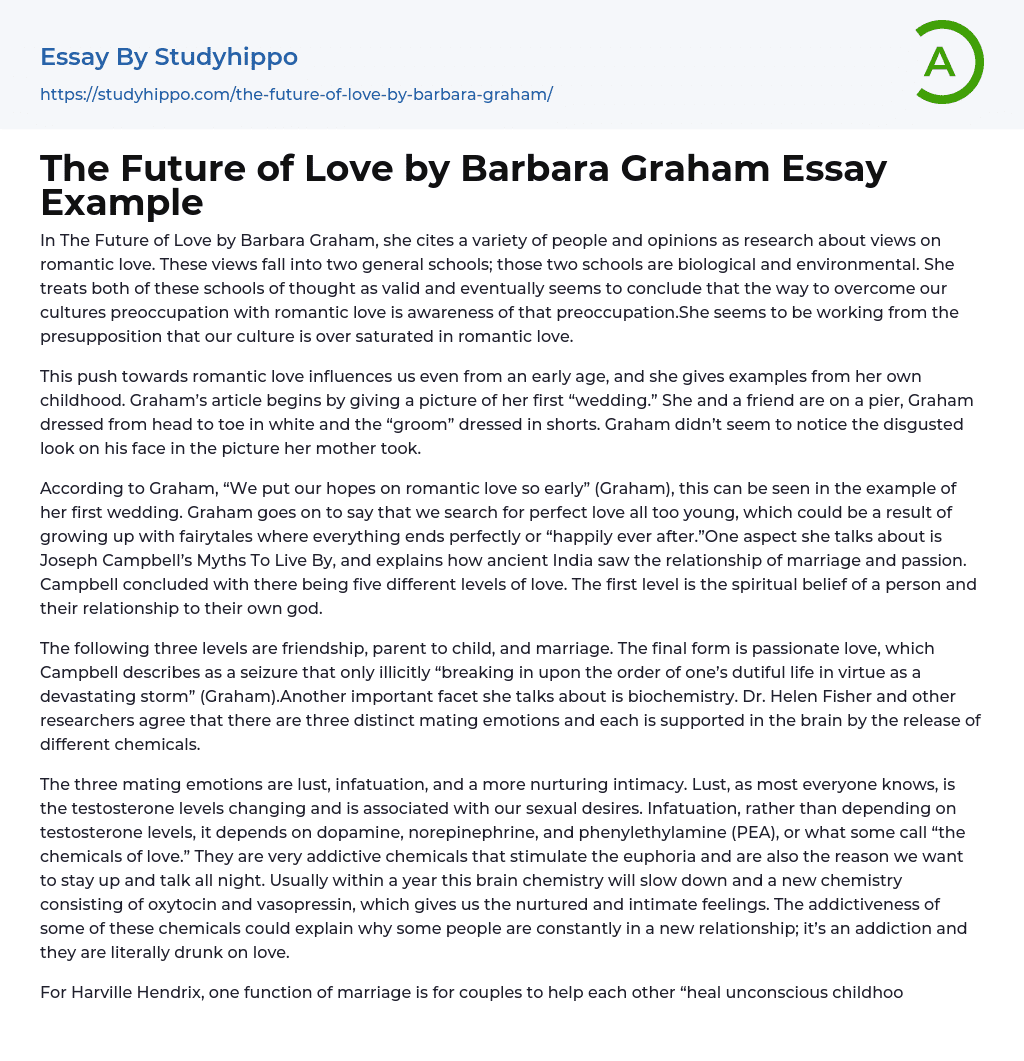In The Future of Love by Barbara Graham, she cites a variety of people and opinions as research about views on romantic love. These views fall into two general schools; those two schools are biological and environmental. She treats both of these schools of thought as valid and eventually seems to conclude that the way to overcome our cultures preoccupation with romantic love is awareness of that preoccupation.She seems to be working from the presupposition that our culture is over saturated in romantic love.
This push towards romantic love influences us even from an early age, and she gives examples from her own childhood. Graham’s article begins by giving a picture of her first “wedding.” She and a friend are on a pier, Graham dressed from head to toe in white and the “groom” dressed in short
...s. Graham didn’t seem to notice the disgusted look on his face in the picture her mother took.
According to Graham, “We put our hopes on romantic love so early” (Graham), this can be seen in the example of her first wedding. Graham goes on to say that we search for perfect love all too young, which could be a result of growing up with fairytales where everything ends perfectly or “happily ever after.”One aspect she talks about is Joseph Campbell’s Myths To Live By, and explains how ancient India saw the relationship of marriage and passion. Campbell concluded with there being five different levels of love. The first level is the spiritual belief of a person and their relationship to their own god.
The following three levels are friendship, parent to child, and marriage. The final form is
passionate love, which Campbell describes as a seizure that only illicitly “breaking in upon the order of one’s dutiful life in virtue as a devastating storm” (Graham).Another important facet she talks about is biochemistry. Dr. Helen Fisher and other researchers agree that there are three distinct mating emotions and each is supported in the brain by the release of different chemicals.
The three mating emotions are lust, infatuation, and a more nurturing intimacy. Lust, as most everyone knows, is the testosterone levels changing and is associated with our sexual desires. Infatuation, rather than depending on testosterone levels, it depends on dopamine, norepinephrine, and phenylethylamine (PEA), or what some call “the chemicals of love.” They are very addictive chemicals that stimulate the euphoria and are also the reason we want to stay up and talk all night. Usually within a year this brain chemistry will slow down and a new chemistry consisting of oxytocin and vasopressin, which gives us the nurtured and intimate feelings. The addictiveness of some of these chemicals could explain why some people are constantly in a new relationship; it’s an addiction and they are literally drunk on love.
For Harville Hendrix, one function of marriage is for couples to help each other “heal unconscious childhood wounds and unmet needs” (Graham). He goes on to explain that love is a process based primarily on our childhood and while with every intent to find someone not like our parents, most are attracted to potential spouses who resemble both our parents. Graham mentions others, such as Jacob Needleman, who believe love is a mixture of body, mind and spirituality.She seems to come to the conclusion that
the best way to deal with human longing is to be conscious of it.
Not to try to get rid of it but to deal with it and try to direct it to something more transcendent. I think that maybe the author experienced a compulsion toward romantic relationships in a more intense manner than I have ever felt or experienced. I think she is overstating society’s impact on the individual in regards to the way it influences our thinking of love. On the other hand, I have seen in my sister the way society impacts when she invented an imaginary boyfriend complete with a background story and a Myspace. Even though she clarified that he was imaginary she still liked the idea of him so much she kept him around as a running joke for years. To some extent, especially when younger, we act as though love is a joke or a game we can play with.
The article “The Future of Love” is a psychological and biochemical analysis on love. Barbara Graham expresses her own opinion in this article in hopes of showing that romantic love is very rare or even nonexistent. Graham explains her views in a somewhat firm manner and does go slightly off course sometimes, but does so with confidence. I believe it was a fairly good article and would recommend it to those who want to know the science behind love.
- Values of Life essays
- Ethical dilemma essays
- Normative Ethics essays
- Virtue Ethics essays
- Belief essays
- Deontology essays
- Moral essays
- Virtue essays
- Work Ethic essays
- Acceptance essays
- Age Of Enlightenment essays
- Child Observation essays
- Confucianism essays
- Conscience essays
- Critical Reflection essays
- Destiny essays
- Determinism essays
- Empiricism essays
- Environmentalism essays
- Epistemology essays
- Ethics essays
- Ethos essays
- Existence essays
- Existentialism essays
- Fate essays
- Free Will essays
- Functionalism essays
- Future essays
- Good And Evil essays
- Human Nature essays
- Individualism essays
- Meaning Of Life essays
- Metaphysics essays
- Natural Law essays
- Personal Philosophy essays
- Philosophers essays
- Philosophy Of Life essays
- Political Philosophy essays
- Pragmatism essays
- Reality essays
- Relativism essays
- Teaching Philosophy essays
- Time essays
- Transcendentalism essays
- Truth essays
- Utilitarianism essays
- Adoption essays
- Aunt essays
- Babies essays
- Bedroom essays




